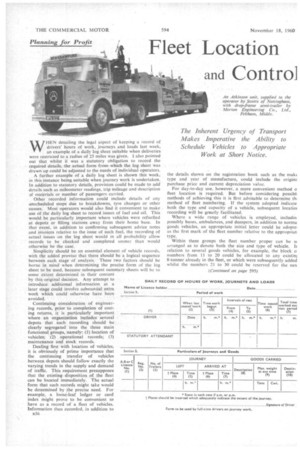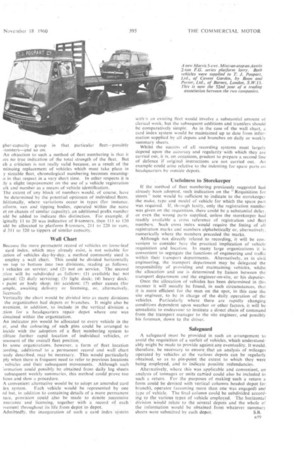Fleet Location
Page 90

Page 93

If you've noticed an error in this article please click here to report it so we can fix it.
and Contra]
The Inherent Urgency of Transport Makes Imperative the Ability to Schedule Vehicles to Appropriate Work at Short Notice.
WHEN detailing the legal aspect of keeping a record of drivers' hours of work, journeys and loads last week, an example of a daily log sheet suitable when deliveries were restricted to a radius of 25 miles was given. I also pointed out that whilst it was a statutory obligation to record the required details, the actual form from. which the log sheet was drawn up could be adjusted to the needs of individual operators.
A further example of a daily tog sheet is shown this week, in this instance being suitable when journey work is undertaken. In addition to statutory details, provision could be made to add details such as mileometer readings, trip mileage and description DI materials or number of passengers carried.
Other recorded information could include details of any unscheduled stops due to breakdowns, tyre changes or other causes. Most operators would also find it convenient to make use of the daily log sheet to record issues of fuel and oil. This would be particularly important where vehicles were refuelled at depots or filling stations away from their home base. In that event, in addition to confirming subsequent advice notes and invoices relative to the issue of such fuel, the recording of actual issues on the log sheet would in all probability allow records to be checked and completed sooner than would otherwise be the case.
Simplicity should be an essential element of vehicle records, with the added proviso that there should be 'a logical sequence between each stage of analysis. These two factors should be borne in mind when determining the precise form of the log sheet to be used. because subsequent summary sheets will be to some extent determined in their content by this original decision. Any attempt to introduce additional information at a later stage could involve substantial extra work which could otherwise have been avoided.
Continuing consideration of engineering records, prior to completion of costing returns, it is particularly important where an organization includes several depots that such recording should be clearly segregated into the three main functional groups, namely: (1) location of vehicles; (2) operational records; (3) maintenance and stock records.
Dealing first with location of vehicles, it is obviously of prime importance that the continuing transfer of vehicles between depots should follow exactly the varying trends in the supply and demand of traffic. This requirement presupposes that the existing disposition of the fleet can be located immediately. The actual form that such records might take would be determined by the precise need. For example, a loos-leaf ledger or card index might prove to be convenient to have as a record of a fleet of vehicles. Information then recorded, in addition to n56
the details shown on the registration book such as the makt type and year of manufacture, could include the origina purchase price and .current depreciation value.
For day-to-day use, however, a more convenient method o fleet location is required. But before considering possibl, methods of achieving this it is first advisable to determine thi method of fleet numbering. If the system adopted indicate both the type and capacity of a vehicle, subsequent locatioi recording will be greatly facilitated.
Where a wide range of vehicles is employed, includin possibly buses, ambulances, and dumpers, in addition to norma goods. vehicles, an appropriate initial letter could be adoptei as the first mark of the fleet number relative to the appropriat, type.
Within these groups the fleet number proper can be st arranged as to denote both the size and type of vehicle. It relation to several goods vehicles, for example, the block cr numbers from 11 to 20 could be allocated to any existim 8-tonner already in the fleet, or which were subsequently added whilst the numbers 21 to 30 could he reserved for the nex gher-capacity group in that particular fleet—possibly -tonners--and so on.
An objection to such a method of fleet numbering is that it ies no true indicationof the total strength of the fleet. But ch a criticism is not really valid because, as a result of the ntinning replacement of vehicles which must take place in y sizeable fleet, chronological numbering becbmes'meaning;s in that respect in a very short time. In other respects it is ily a slight improvement on the use of a vehicle registration ark and number as a means of vehicle identification.
The extent of any block Of numbers would, of course, have be determined by the potential optimum of individual fleets, :Iditionally, where variations occur in typeS. (for instance. Atform, van and tipping bodies, operated within the same et on chassis of similar capacity), an additional prefix number uld he added to indicate this distinction. For example, if iginally 11 to 20 was indicative of -8-tonners, then 111 to 120 uld he allocated to platform 8-tonners, 211 to 220 to vans, d 311 to 320 to tippers of similar capacity.
Wall Chart Because the more permanent record of vehicles on loose-leaf card index, which May already exist, is not suitable for :ation of vehicles day-by-day, a method commonly used is employ a wall chart. This could be divided horizontally -am top to bottom into two divisions, reading as follows:
I vehicles on service; and (2) not on service. The second :tion will be subdivided as follows: (1) available but not 4uired: (2) daily servicing; (3) light dock; (4) heavy dock: paint or body shop; (6) accident; (7) other causes (for ample, awaiting delivery or licensing, or, alternatively, licensed).
Vertically the chart would be divided into as many divisions the organization had depots or branches. It might also be nvenient, in addition, to include in the vertical division a :lion for a headquarters repair • depot where one was untamed within the organization.
An indicator pin would be allocated to every vehicle in the et, and the colouring of such pins could be arranged to irickle with the adoption of a fleet numbering system to :ilitate further rapid location of individual vehicles, or ;essment of the overall fleet position.
In some organizatiohs, however, a form of fleet location xrding, additional to a permanent record and wall chart .eady described. may be necessary. This would •particularly ply when there is frequent need to refer to previous locations vehicles and their subsequent movements. Although such 'ormation could possibly be obtained from daily log sheets subsequent weekly summaries, this method could prove too lions and slow a procedure.
A convenient alternative would be to adopt an amended card lex system. Each vehicle would he represented by one rd but, in addition to containing details of a more permanent.
ture. provision could also be made to denote 5u.cc6sive nsurance and licensing, together With a record of each )vement throughout its life from depot to depot.
Admittedly. the inauguration of such a card index :system withEn an existing fleet would involve a substantial amount ot clerical work. but the subsequent additions and transfers should be comparatively simple. As in the case of the wall chart, a card index system would be maintained up to date from information supplied by all depots and branches on daily or weekly surnmary sheets.
Whilst the success of all recording systems must largely depend upon the accuracy and regularity with which they arc carried out, it is, on occasions, prudent to prepare a second line of defence. if original instructions are not carried out. An example could arise relative to the indenting for spare parts on headquarters by outside depths.
Usefulness :10 Storekeeper If the method of fleet numbering previously suggested had already been adopted, such indication on the "Requisition for stores" note would be sufficient to indicate to the storekeeper the make, type and model of vehicle for which the spare part was required. If, through laxity, only the registration number was given on the requisition. there could be a substantial delay. or even the wrong parts supplied, unless the storekeeper had readily available a cross reference of registration and fleet numbers. Such cross index Would require the listing of all registration marks and numbers alphabetically. or, alternatively. numerically where the numbers preceded the marks.
Although not directly i-elated to recording, it will be convenient to consider here the practical implication of vehicle requisition and location. In many large organizations it is convenient to segregate the function.s of engineering and traffic within their transport departments. Alternatively, as in civil engineering, the transport department may be delegated the responsibility of providing and maintaining: vehicles, whilst the allocation and use is determined by liaison between the transport department and the engineer-on-site, or his deputies Once the allocation of vehicles has been determined in this manner it will usually be found, in such circumstances, that it is more efficient for the man on the spot; in this case the site engineer, to be in charge of the daily ,operation of the vehieles.'Particularly where there are rapidly changing conditions dependent upon weather or other factors, it will be unrealistic to endeavour to institute a direct chain of command from the transport manager to the site engineer, and possibly his foreman, down to the driver.
Safeguard A safeguard must be provided in such an arrangement to avoid the requisition of a surfeit of vehicles, which understandably might be made to provide against any eventuality, It would. therefore, be necessary to ensure that an analysis of mileages operated by vehicles at the various. depots can be regularly obtained, so as to pin-point the extent to which they were being employed, and to indicate possible redundancies.
Alternatively, where this was applicable and convenient, an analysis of tonnages or units carried could also be included in such a return. For the purposes of making such a return a form could be devised with vertical columns headed depot (or branch), operator (assuming more than one Was engaged) and type of vehicle. The final column could be subdivided according.to the various types Of vehicle employed: The horizontal division would relate to the .several depots and the whole of the information. 'Would be obtained from whatever summary
sheets were submitted by each depot. S.B.




































































































































